North America is home to at least 635 distinct species of snakes, with ranges dispersed throughout the continent. Over 180 of those species live in the United States specifically, and of those, approximately 30 species belong to the viper family. More specifically, North American vipers all belong to the pit viper subfamily, Crotalinae.
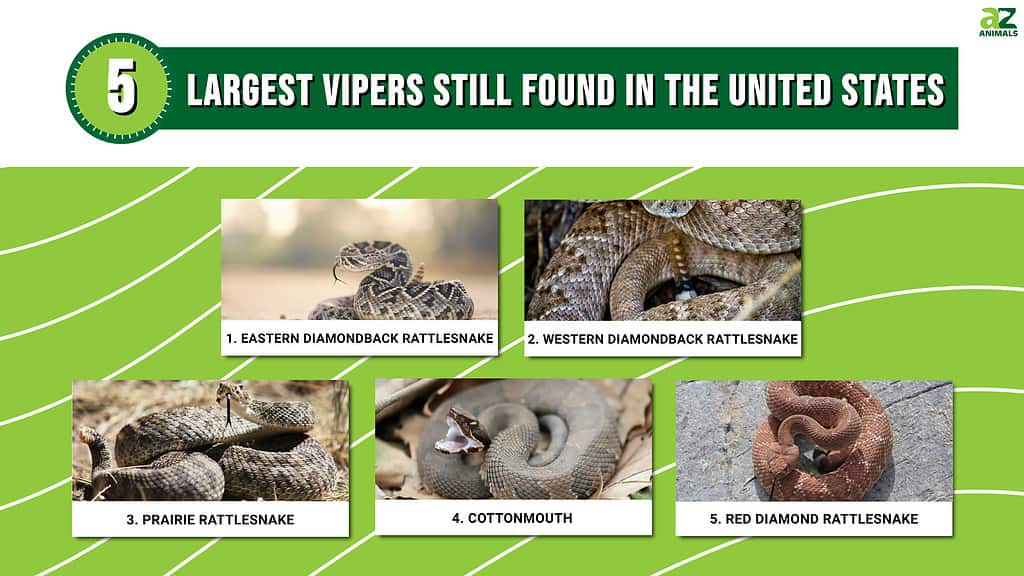
Many people fear pit vipers for their venom, and their fears are not entirely unfounded. These snakes can be quite dangerous if provoked. However, when treated with respect, the odds of being bitten by these vipers are pretty low. Most of the time, they’d rather run away than risk injury in an unnecessary fight. In fact, most venomous snakebites occur accidentally, or in incidents where humans are threatening or approaching a snake — not the other way around!
These snakes are not just the largest vipers in the country — some of them also rank among the largest vipers in the world! There is quite a bit of variation among them, even between members of the same species. Below, we’ll list their average lengths as well as the length of the longest member of the species on record. We’ll find out just how big these venomous serpents can get, where you’re likely to find them and learn some interesting facts about each one.
1. Eastern Diamondback Rattlesnake (Crotalus adamanteus) — 33–72 inches
Of the 32 or so species of rattlesnakes on the continent, the eastern diamondback (Crotalus adamanteus) is the largest. While most adults of the species average between 33 and 72 inches in length, the longest diamondback on record measured a full 8 feet long! That’s about as long as the height of an average household wall. In addition to their impressive lengths, eastern diamondbacks tend to be quite bulky. Adults can weigh more than 10 pounds!
As its name suggests, the eastern diamondback rattlesnake resides only in the country’s southeast. While most of these snakes live in Florida and south Georgia, their range extends northward into North Carolina and westward into Louisiana as well. They live primarily in dry, sandy habitats, like coastal dunes, sandy flats, and pine stands. While they are very strong swimmers, traversing the brackish waters along the coast, they tend to avoid wet habitats and swampy areas overall.
Unfortunately, due to a variety of factors, eastern diamondbacks are in decline throughout their range. With the expansion of human settlements and highways, habitat destruction, and roadkill deaths are on the rise. Large snakes tend to scare people and the eastern diamondback, as the largest viper in the country, tends to draw a lot of undue negative attention. In some areas of the south, residents are encouraged to participate in rattlesnake roundups, where these and other snakes are gathered up by the hundreds and killed outright. While these events have begun to decline in recent years, the damage they have historically caused to the diamondback population is evident.
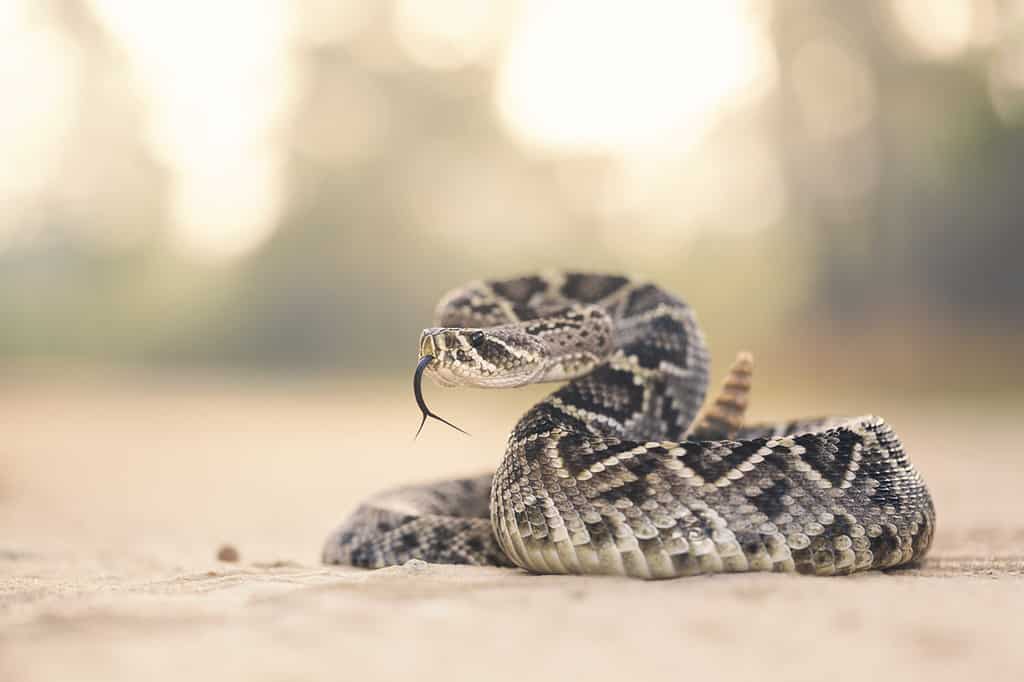
These misunderstood snakes are in decline throughout the southeast due to habitat loss and roadkill deaths. Unfortunately, some people even kill them intentionally.
©Kristian Bell/Shutterstock.com
2. Western Diamondback Rattlesnake (Crotalus atrox) — 24–72 inches
The second largest viper in the country inhabits the southwestern United States and Mexico. It is not overly picky about its habitat and will live in scrub forests, rocky fields, or other places that provide them with cover from predators. Like the eastern diamondback, the western diamondback rattlesnake (Crotalus atrox) prefers fairly dry living conditions. It appears in places like Texas, Arizona, New Mexico, Oklahoma, and Southern California. Its range also extends well into Mexico.
Like its eastern cousin, the western diamondback can grow to impressive lengths for a viper. While most adults of the species range between 2 and 6 feet in length, the largest western rattler on record measured a whopping 90 inches long! Western diamondbacks have stout bodies, triangular heads, and of course, a rattle at the end of their tails. Very young rattlesnakes have small button-like rattles that grow in size as they age. Measuring rattle size isn’t a good way to estimate a snake’s age, however, as they sometimes break or fall off with regular shedding.
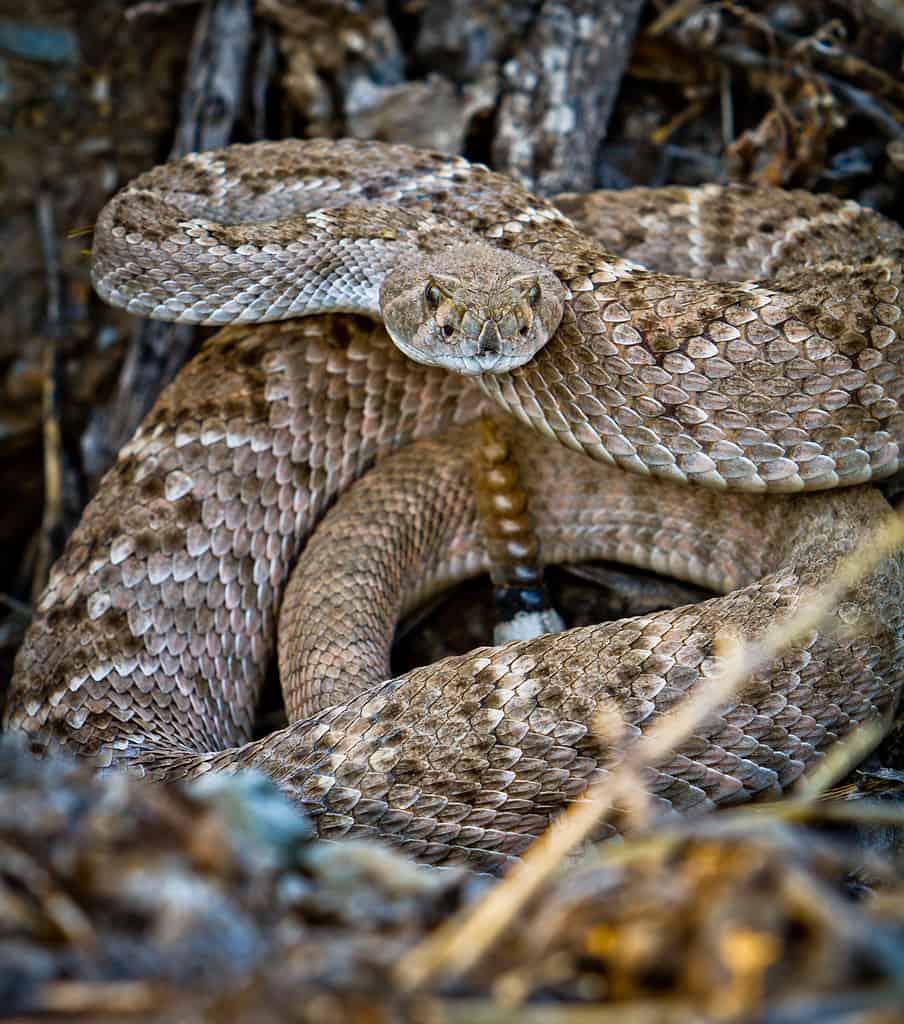
The largest Western diamondback on record measured an incredible 7 and a half feet long!
©PhilBilly/iStock via Getty Images
Unfortunately, rattlesnake roundups aren’t unique to the East Coast. These brutal events occur in the southwest as well, causing unnecessary harm to the snakes and disrupting the balance of the ecosystems they help maintain. Luckily, western diamondbacks are quite prolific and their populations today are stable.
Though bites from the western rattlesnake are relatively common, it isn’t because the snakes are aggressive. Rather, it is because western diamondbacks are common throughout the areas they inhabit and readily defend themselves when they feel threatened. Unantagonized, these snakes avoid humans and are quite reclusive. When they do bite an animal, it is usually one they are trying to eat.
3. Prairie Rattlesnake (Crotalus viridis) — 36–60 inches
Ranking as the third-largest viper on our list is the prairie rattlesnake (Crotalus viridis). These snakes inhabit a massive range, from southwestern Canada into the U.S., from Montana and Idaho to the Midwest, and southward to Texas. They even inhabit parts of northern Mexico.
These snakes range from 3 to 5 feet long on average, with the longest on record representing the extent of that range at 60 inches. Though the record size isn’t the largest on the list, snakes of this species frequently average lengths of 3 feet or more.
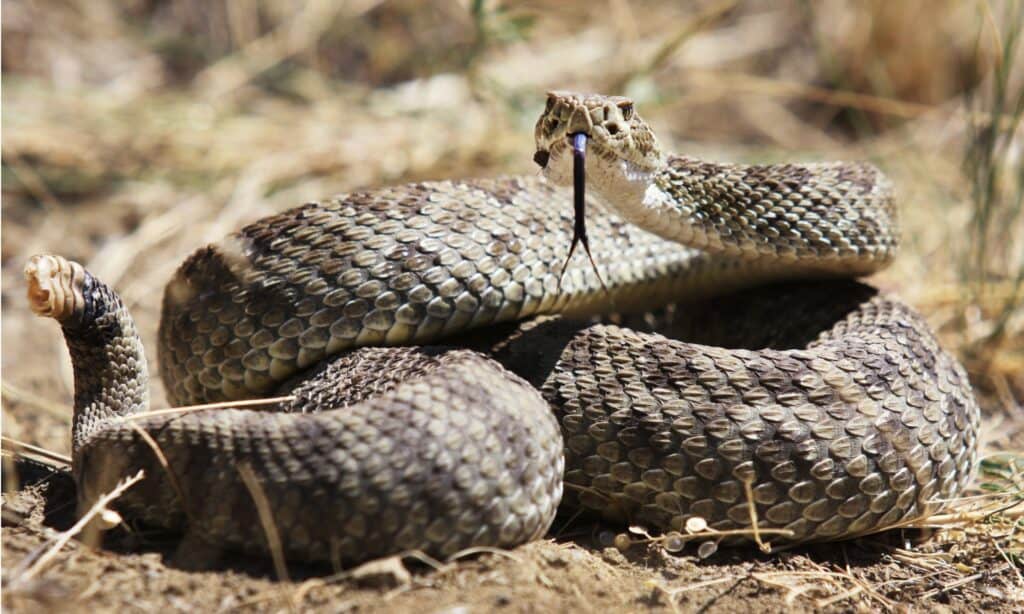
The prairie rattlesnake inhabits an incredibly wide range across North America, appearing much farther north than its desert-dwelling cousins.
©iStock.com/HRossD
Prairie rattlesnakes are generally light brown in overall color and have a series of dark brown blotches that run down their backs. These blotches usually have tan or white borders, but this isn’t always the case. Toward the end of its body, the pattern switches
Because of their blotches and largely brown coloration, even adult prairie rattlesnakes are easy to mistake for small western diamondbacks. The greatest factor to consider when trying to distinguish between the two species is their distribution. While prairie rattlers have an incredibly wide native range, western diamondbacks are limited to the southern U.S. and northern Mexico. If you are in an area where their ranges overlap, other characteristics can help distinguish between them. Although they aren’t hard rules, prairie rattlers are usually thinner overall and have much wider white bands on their tails, just before their rattles.
4. Cottonmouth (Agkistrodon piscivorus) — 24–48 inches
Did you know that one of the only semiaquatic vipers in the world lives in the United States? Various subspecies of the cottonmouth (Agkistrodon piscivorus), or water moccasin, inhabit a wide range of wet habitats throughout the Southeast, from Florida to southeastern Virginia and westward to Texas, Missouri, southern Illinois, and Indiana. Spending most of their lives in or near the water, they appear most frequently in dense, lush wetlands, swamps, and river floodplains. They are commonly found basking on rocks, branches, or fallen trees near a body of water.
Cottonmouths are fairly large snakes, averaging between 2 and 4 feet in length. The largest one on record, however, measured just over 6 feet long! On average, it is the fourth-largest viper in North America.
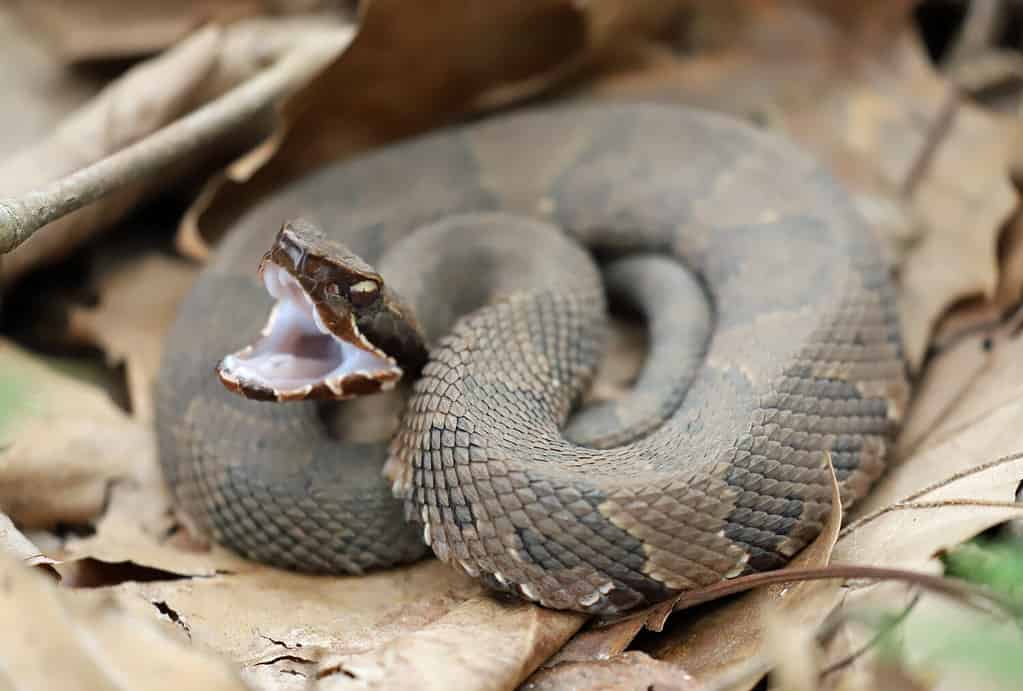
This cottonmouth is gaping, showing its white mouth as a warning.
©KF2017/Shutterstock.com
Cottonmouth coloration is highly variable, and many people simply steer clear of snakes they can’t identify. Adults of the species may have dark crossbands running the length of their bodies, or be solid black, gray, or brown and entirely without patterning. Juveniles are much easier to identify, as they are born with bright yellow-tipped tails, which they use to lure in potential prey. As they age, the yellow tip fades into the rest of their body coloration. Regardless of age, cottonmouths never have a rattle.
These snakes get their name from the stark white coloration of their mouths, which they present as part of their defensive stance. This is not an aggressive maneuver! It serves to increase the snake’s visibility in relation to its background and warn potential predators of its venomous nature. If a human or other animal continues to approach, the snake is fairly likely to bite rather than retreat. They will not, however, chase a person as they retreat, regardless of their reputation for doing so.
5. Red Diamond Rattlesnake (Crotalus ruber) — 24–36 inches
The final and fifth-largest viper in North America is the red diamondback rattlesnake (Crotalus ruber). It inhabits a small region of the United States and Mexico, with a range limited to southern California and the Baja Peninsula. They also inhabit several islands in the Gulf of California.
Red diamondbacks average between 2 and 3 feet long, with males being larger than females. While it is rare to find a red diamondback in the 5-foot range, the longest specimen on record measured an incredible 64 inches. That’s more than 2 feet longer than average!
Unlike cottonmouths whose coloration can vary quite wildly, the red diamondback rattlesnake has prominent features that make it easy to identify. It exhibits a bright, rusty red-brown coloration with a characteristic diamond-shaped pattern that runs the length of its back. Just before the tail, the diamond pattern abruptly switches to one of black and white horizontal stripes. These stripes continue until they meet the snake’s rattle at the tip of its tail.
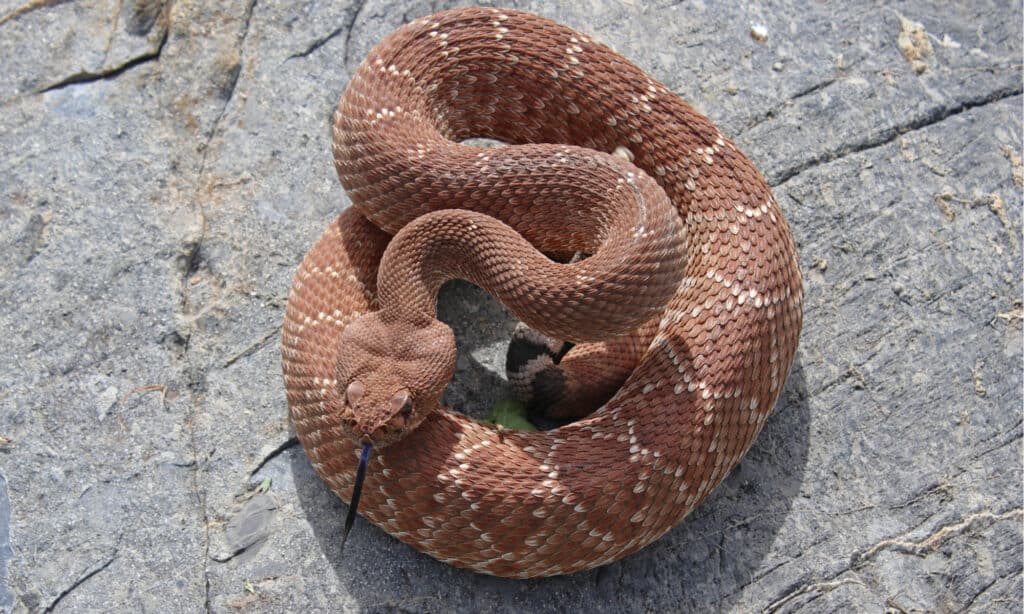
Their wide, angular heads and rusty-red coloration make red diamondbacks easy to identify.
©Creeping Things/Shutterstock.com
Like its rattlesnake relatives, the red diamondback is pretty reclusive. It prefers to hide among rocks, boulders, and coastal and desert scrub. These areas provide them with good cover from predators like hawks, weasels, and other snakes. Conveniently, they also give the snake comfortable hides from which to ambush prey animals like rodents and lizards.
While these snakes are not in danger of extinction, the expansion of human settlements is threatening their habitat. As housing and industrial developments continue to grow outward, they replace the scrub that these snakes rely on to survive. Though the IUCN lists the species as Least Concern, the California Department of Fish and Game notes the changing region and lists them as a Species of Special Concern.
Summary of 5 Largest Viper Species in the United States
| # | Species | Average Adult Size | Record Size |
|---|---|---|---|
| 1 | Eastern Diamondback Rattlesnake (Crotalus adamateus) | 33 – 72 inches | 96 inches |
| 2 | Western Diamondback Rattlesnake (Crotalus atrox) | 48 – 60 inches | 90 inches |
| 3 | Prairie Rattlesnake (Crotalus viridis) | 36 – 60 inches | 60 inches |
| 4 | Cottonmouth (Agkistrodon piscivorus) | 24 – 48 inches | 74 inches |
| 5 | Red Diamondback Rattlesnake (Crotalus ruber) | 24 – 36 inches | 64 inches |
The photo featured at the top of this post is © Creeping Things/Shutterstock.com
Discover the "Monster" Snake 5X Bigger than an Anaconda
Every day A-Z Animals sends out some of the most incredible facts in the world from our free newsletter. Want to discover the 10 most beautiful snakes in the world, a "snake island" where you're never more than 3 feet from danger, or a "monster" snake 5X larger than an anaconda? Then sign up right now and you'll start receiving our daily newsletter absolutely free.
Thank you for reading! Have some feedback for us? Contact the AZ Animals editorial team.






